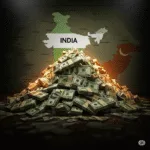“In a world where tariffs reshape industries, India faces the challenge of navigating a trade landscape that impacts everything from agriculture to tech, automotive to textiles. With over $100 billion in trade exposure, the stakes for sectors and jobs are higher than ever.”
A Shift Across the Seas
When Donald Trump returned to the White House in 2025, he didn’t waste time shaking up the global economy. Slapping new tariffs on imported goods, including those coming from India. While it may sound like something far away from our daily lives, this decision could quietly—but powerfully—impact everything from the cost of living to jobs across India.
Let’s break it down in plain terms: What exactly are these tariffs, and what might they mean for you, me, and the Indian economy?
Table of content
- What Are Tariffs, and Why Is Trump Using Them Again?
- How Big Is India’s Trade with the U.S.?
- Sectors That May Feel the Heat and their employment at stack.
- Jobs at Stake: The Human Angle
- Could India Respond with Tariffs of Its Own?
What Are Tariffs, and Why Is Trump Using Them Again?
Continue reading ⤵
💼 “Tariffs are the taxes of tension—raised in hope, paid in retaliation.”
Tariffs are taxes on imported goods. When a country like the U.S. puts tariffs on things made in India, those Indian products become more expensive for American buyers. Trump’s argument is that this helps American manufacturers by encouraging people to buy “Made in the USA.”
In 2025, Trump raised tariffs on countries he feels are “unfairly benefiting” from trade with the U.S. This includes China, Mexico—and India. Sectors like steel, pharmaceuticals, and textiles are directly affected, while the ripple effect touches many others.
How Big Is India’s Trade with the U.S.?
🌍 “In every container that crosses oceans lies a thread binding economies—and millions of livelihoods.”
India and the U.S. have a strong trade relationship. In 2024, India exported goods worth $112 billion to the U.S., including software services, pharmaceuticals, textiles, gems, and machinery. America is India’s largest export market.
Now with increased tariffs, some of these goods become more expensive in the U.S., meaning American buyers might reduce their orders. That could hit Indian companies hard.s.
Sectors That May Feel the Heat
1.Textiles & Garments

🧵 “In Tiruppur’s rhythmic looms, even a thread of tariff trembles the entire weave.”
India is a global hub for garments and textiles. The U.S. is a major buyer. With new tariffs (as high as 20% on some categories), Indian clothes might lose price advantage over competitors like Vietnam and Bangladesh. That could lead to order losses and factory slowdowns, especially in Tirupur, Ludhiana, and Surat.
Estimated Employment: ~45 million
Tariffs may reduce U.S. demand, leading to decreased exports and potential job losses, especially in export-focused regions like Tirupur and Ludhiana.
2.Pharmaceuticals

💊 “Healing hands from Hyderabad face hurdles as policy walls rise around global care.”
India’s generic medicines have been a lifesaver—literally and economically. In 2024, pharma exports to the U.S. were worth $8 billion. New tariffs of around 10–15% could dent margins for companies like Sun Pharma and Dr. Reddy’s. While demand for life-saving drugs may not disappear, pricing pressures could reduce profits and future investments.
Estimated Employment: ~2.7 million
Increased tariffs could make Indian generics less competitive in the U.S., potentially affecting export volumes and employment in pharma hubs like Hyderabad and Ahmedabad.
3. IT & Services

💻 “India’s coders write the future, but tariffs threaten to rewrite their reach.”
Although tariffs generally apply to physical goods, India’s IT services may feel an indirect impact. If American companies face cost pressures due to tariffs, they might cut back on outsourcing or renegotiate contracts—affecting jobs in India’s tech hubs like Bengaluru, Hyderabad, and Pune.
Estimated Employment: ~4.5 million
While not directly tariffed, reduced U.S. corporate spending might lead to fewer outsourcing contracts, impacting employment in tech centres such as Bengaluru and Pune.
4. Automotive Parts

🚗 “From Pune’s factories to U.S. roads, every bolt now bears the weight of politics.”
India exports a significant amount of auto parts and components to the U.S. The Auto Component Manufacturers Association (ACMA) estimated exports at $2.2 billion in 2024. A 10% tariff here could affect small and medium enterprises (SMEs) across Pune, Gurugram, and Chennai.
Estimated Employment: ~5 million
Tariffs on auto parts could decrease exports to the U.S., affecting jobs in manufacturing clusters like Pune and Chennai.
5. Agriculture: Sowing in Uncertain Soil

🌾 “From Punjab’s grain to Maharashtra’s mango, the global table is shifting under India’s harvest.”
India’s agricultural exports to the U.S., including basmati rice, spices, and tea, were valued at over $1.8 billion in 2024, as per data from the Agricultural and Processed Food Products Export Development Authority (APEDA). A proposed 10–15% tariff hike could dampen demand, especially for premium organic produce. States like Punjab, Haryana, and Kerala may feel the pressure, impacting incomes for millions of small-scale farmers who rely on U.S. markets for profitability.
Estimated Employment: ~280 million
Though the U.S. is not a major importer of Indian agricultural produce, tariffs can create ripple effects in global commodity prices. This may affect Indian farmers’ export margins for items like rice, spices, and tea.
6.MSMEs (Micro, Small & Medium Enterprises)

🏭 “In the hum of small workshops, even a whisper of tariffs echoes like a storm.”
MSMEs form the backbone of India’s export economy, contributing nearly 40% to India’s total exports and employing over 120 million people. In 2024, U.S.-bound exports from MSMEs—particularly in textiles, handicrafts, and leather goods—stood at approximately $18 billion, according to the Ministry of MSME. Fresh tariffs could lead to order cuts and operational challenges, especially in export hubs like Tiruppur, Jaipur, and Moradabad, which heavily depend on U.S. buyers.
Estimated Employment: ~120 million
MSMEs that depend on exports, particularly in handicrafts, leather, and textiles, could see a drop in U.S. orders. This could lead to cash flow issues and employment reduction in export-heavy regions like Uttar Pradesh and Gujarat.
Jobs at Stake: The Human Angle
Behind every export figure, there’s a worker. If U.S. companies start cutting orders, Indian factories may scale down production. That means job cuts or halted hiring, especially in labour-intensive sectors like garments and auto parts.
According to industry bodies, around 5 lakh jobs (500,000) could be at moderate-to-high risk across various sectors if these tariffs continue into 2026.
But there’s a silver lining—India is already pushing to diversify export markets, looking toward Europe, Africa, and Southeast Asia to reduce reliance on the U.S. This might take time, but it offers long-term relief.
Could India Respond with Tariffs of Its Own?
In theory, yes. India has the ability to impose retaliatory tariffs on U.S. imports, but it’s approaching this cautiously. The government is focused on striking a balance—protecting local industries without escalating tensions. Instead of direct retaliation, we’re more likely to see strategic policy moves, such as boosting incentives for exporters, streamlining logistics, or offering currency support, all designed to shield domestic markets without triggering a trade war.
“Sharing is caring! Share this article to spread the word“
Source:
- India’s Ministry of Commerce and Industry
- Federation of Indian Export Organisations (FIEO)
- Economic Times – Trade News
- World Trade Organization (WTO)
- World Bank – India Trade Reports
- United States Trade Representative (USTR)
- Reuters – Trade Section
- Bloomberg – Global Trade
Disclaimer:
The views and opinions expressed in this article are for informational purposes only. While every effort has been made to ensure the accuracy of the data, the content reflects general insights into the impact of U.S. tariff policies on India’s sectors and employment. The figures and forecasts presented are based on the most recent available data at the time of writing and may change due to evolving trade conditions or government policies. Readers should consult official sources and experts for up-to-date, personalized advice.




























Leave a Reply